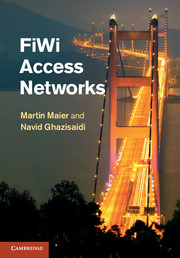Book contents
- Frontmatter
- Contents
- List of figures
- List of tables
- Preface
- Acknowledgments
- Part I Introduction
- Part II Fiber access networks
- Part III Wireless access networks
- Part IV FiWi access networks
- 10 RoF vs. R&F networks
- 11 Architectures
- 12 Network planning and reconfiguration
- 13 Techno-economic analysis
- 14 Network coding
- 15 Optical and wireless protection
- 16 Hierarchical frame aggregation
- 17 Routing and QoS continuity
- 18 Smart grid communications
- References
- Index
12 - Network planning and reconfiguration
from Part IV - FiWi access networks
Published online by Cambridge University Press: 05 January 2012
- Frontmatter
- Contents
- List of figures
- List of tables
- Preface
- Acknowledgments
- Part I Introduction
- Part II Fiber access networks
- Part III Wireless access networks
- Part IV FiWi access networks
- 10 RoF vs. R&F networks
- 11 Architectures
- 12 Network planning and reconfiguration
- 13 Techno-economic analysis
- 14 Network coding
- 15 Optical and wireless protection
- 16 Hierarchical frame aggregation
- 17 Routing and QoS continuity
- 18 Smart grid communications
- References
- Index
Summary
To maximize the performance of FiWi networks and minimize their deployment costs, network planning and reconfiguration play a key role in achieving these design objectives. In this chapter, we describe a number of algorithms that help solve important FiWi network planning problems related to the optimal placement of optical network units (ONUs), mitigation of the detrimental impact of wireless interferences for peer-to-peer communications between wireless end-users, and architectural modifications for the support of direct inter-ONU communications. Furthermore, we discuss previously proposed reconfigurable FiWi network architectures that are able to respond to varying traffic loads.
ONU placement
The optimal placement of ONUs is an important design objective of FiWi networks due to the fact that the cost of laying optical fiber is significantly higher than that of devices attached to either end of the optical fiber, e.g., optical line terminal (OLT).
Several heuristics to solve the problem of optimally placing ONUs in a FiWi access network consisting of a passive optical network (PON) in tandem with a WiFi- or WiMAX-based wireless mesh network (WMN) were studied in (Sarkar et al. [2008]). The first proposed heuristic is a greedy algorithm that aims at finding a suitable placement of multiple ONUs to minimize the average Euclidean distance between wireless end-users and their closest ONU, i.e., this heuristic targets only the wireless front-end and does not take the fiber layout of the optical backhaul into account.
- Type
- Chapter
- Information
- FiWi Access Networks , pp. 138 - 145Publisher: Cambridge University PressPrint publication year: 2011



